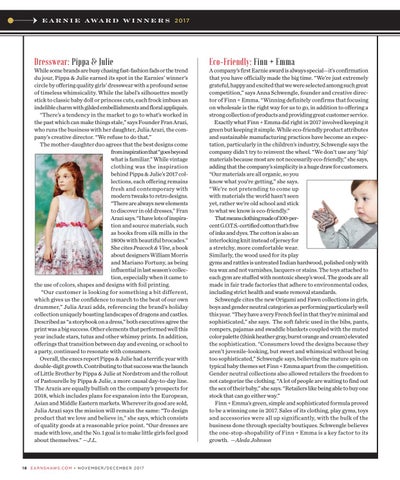e a r n i e awa r d w i n n e r s
18
2017
Dresswear: Pippa & Julie
Eco-Friendly: Finn + Emma
While some brands are busy chasing fast-fashion fads or the trend du jour, Pippa & Julie earned its spot in the Earnies’ winner’s circle by offering quality girls’ dresswear with a profound sense of timeless whimsicality. While the label’s silhouettes mostly stick to classic baby doll or princess cuts, each frock imbues an indelible charm with gilded embellishments and floral appliquĂŠs. “There’s a tendency in the market to go to what’s worked in the past which can make things stale,â€? says Founder Fran Arazi, who runs the business with her daughter, Julia Arazi, the company’s creative director. “We refuse to do that.â€? The mother-daughter duo agrees that the best designs come from inspiration that “goes beyond what is familiar.â€? While vintage clothing was the inspiration behind Pippa & Julie’s 2017 collections, each offering remains fresh and contemporary with modern tweaks to retro designs. “There are always new elements to discover in old dresses,â€? Fran Arazi says. “I have lots of inspiration and source materials, such as books from silk mills in the 1800s with beautiful brocades.â€? She cites Peacock & Vine, a book about designers William Morris and Mariano Fortuny, as being influential in last season’s collection, especially when it came to the use of colors, shapes and designs with foil printing. “Our customer is looking for something a bit different, which gives us the confidence to march to the beat of our own drummer,â€? Julia Arazi adds, referencing the brand’s holiday collection uniquely boasting landscapes of dragons and castles. Described as “a storybook on a dress,â€? both executives agree the print was a big success. Other elements that performed well this year include stars, tutus and other whimsy prints. In addition, offerings that transition between day and evening, or school to a party, continued to resonate with consumers. Overall, the execs report Pippa & Julie had a terrific year with double-digit growth. Contributing to that success was the launch of Little Brother by Pippa & Julie at Nordstrom and the rollout of Pastourelle by Pippa & Julie, a more causal day-to-day line. The Arazis are equally bullish on the company’s prospects for 2018, which includes plans for expansion into the European, Asian and Middle Eastern markets. Wherever its good are sold, Julia Arazi says the mission will remain the same: “To design product that we love and believe in,â€? she says, which consists of quality goods at a reasonable price point. “Our dresses are made with love, and the No. 1 goal is to make little girls feel good about themselves.â€? —J.L.
A company’s first Earnie award is always special—it’s confirmation that you have officially made the big time. “We’re just extremely grateful, happy and excited that we were selected among such great competition,� says Anna Schwengle, founder and creative director of Finn + Emma. “Winning definitely confirms that focusing on wholesale is the right way for us to go, in addition to offering a strong collection of products and providing great customer service. Exactly what Finn + Emma did right in 2017 involved keeping it green but keeping it simple. While eco-friendly product attributes and sustainable manufacturing practices have become an expectation, particularly in the children’s industry, Schwengle says the company didn’t try to reinvent the wheel. “We don’t use any ‘hip’ materials because most are not necessarily eco-friendly,� she says, adding that the company’s simplicity is a huge draw for customers. “Our materials are all organic, so you know what you’re getting,� she says. “We’re not pretending to come up with materials the world hasn’t seen yet, rather we’re old school and stick to what we know is eco-friendly.� That means clothing made of 100-percent G.O.T.S.-certified cotton that’s free of inks and dyes. The cotton is also an interlocking knit instead of jersey for a stretchy, more comfortable wear. Similarly, the wood used for its play gyms and rattles is untreated Indian hardwood, polished only with tea wax and not varnishes, lacquers or stains. The toys attached to each gym are stuffed with nontoxic sheep’s wool. The goods are all made in fair trade factories that adhere to environmental codes, including strict health and waste removal standards. Schwengle cites the new Origami and Fawn collections in girls, boys and gender neutral categories as performing particularly well this year. “They have a very French feel in that they’re minimal and sophisticated,� she says. The soft fabric used in the bibs, pants, rompers, pajamas and swaddle blankets coupled with the muted color palette (think heather gray, burnt orange and cream) elevated the sophistication. “Consumers loved the designs because they aren’t juvenile-looking, but sweet and whimsical without being too sophisticated,� Schwengle says, believing the mature spin on typical baby themes set Finn + Emma apart from the competition. Gender neutral collections also allowed retailers the freedom to not categorize the clothing. “A lot of people are waiting to find out the sex of their baby,� she says. “Retailers like being able to buy one stock that can go either way.� Finn + Emma’s green, simple and sophisticated formula proved to be a winning one in 2017. Sales of its clothing, play gyms, toys and accessories were all up significantly, with the bulk of the business done through specialty boutiques. Schwengle believes the one-stop-shopability of Finn + Emma is a key factor to its growth. —Aleda Johnson
E A R N S H AW S .C O M ĆŤ Ä‘ ĆŤ ÄĽ ĆŤ Ä‚ Ä€ Ä Äˆ
